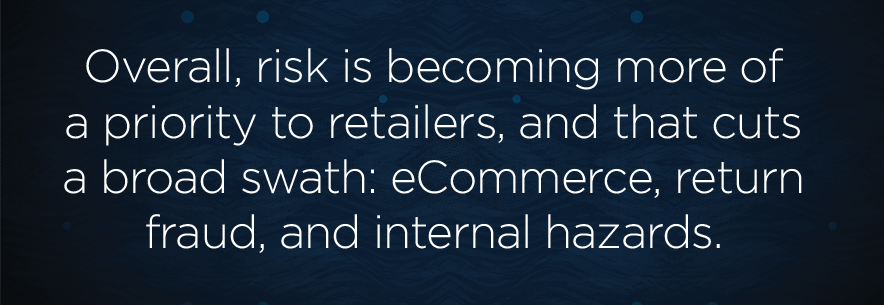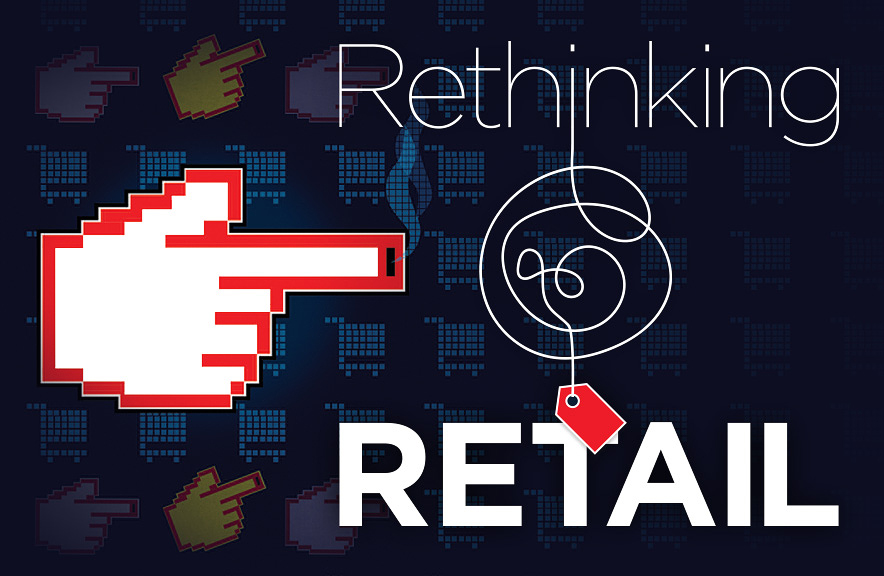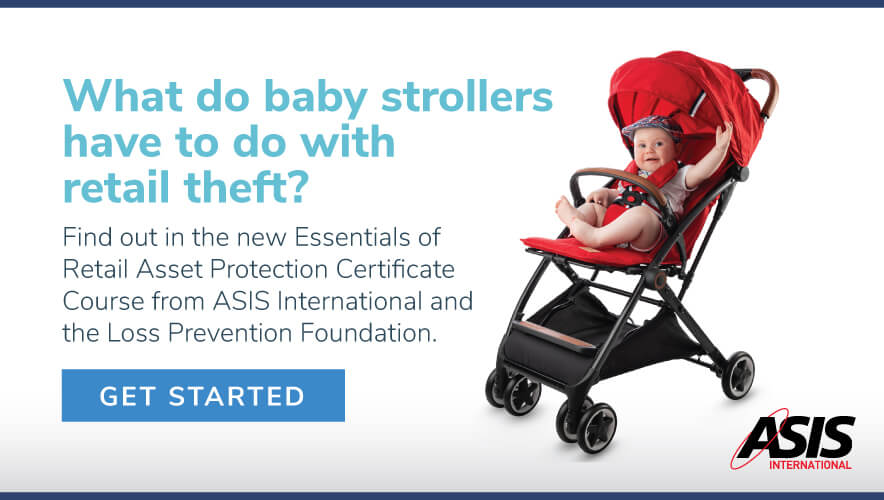Rethinking Retail
Every November in the United States, the busiest shopping day of the year rolls around: Black Friday. In previous years, the day after Thanksgiving often evoked the image of bleary-eyed, keyed-up shoppers waiting in line outside stores in the early morning hours, ready to stampede into malls to hunt down the best deals. But in recent years, the single-day shopping spree expanded into a long weekend of sales, including—with the advent of Cyber Monday—a growing shift to eCommerce.
Online sales hit a new record for that weekend in 2019, according to the National Retail Federation (NRF). “For the first time, Black Friday topped Cyber Monday as the busiest day for online at 93.2 million shoppers compared with 83.3 million,” the NRF found in its 2019 survey of Black Friday.
The 2019 Black Friday holiday weekend resulted in online sales generating $7.4 billion. And while 124 million people visited brick-and-mortar stores throughout those four days (with Friday remaining the busiest day), 142.2 million shoppers used retailers’ websites to take advantage of sales, and 75.7 million did both.
A little more than three months after 2019’s record-breaking Black Friday, with winter holidays disappearing from the rearview mirror, local authorities in King County, Washington, issued the first recommendation for people in vulnerable groups to stay home in an attempt to tamp down the spread of COVID-19. Since then, a total of 42 U.S. states and Washington, D.C., have issued stay-at-home orders as the coronavirus grew into a global pandemic. State and national authorities urged employers to allow for remote work where possible and asked the public to leave their homes or neighborhoods only if necessary.
As a result, many people’s personal and professional lives were further pushed online, and shopping was no exception as consumers sought ways to limit potential sources of exposure. The NRF reported in August that the pandemic accelerated interest in online shopping, but research also found that retailers were adapting to address concerns around the coronavirus, including blending online and offline channels through curbside pickup or personal shopper services. However, these shifts in buying habits and business operations are also linked to evolving risks.
The NRF’s 2020 National Retail Security Survey attempts to measure total retail shrink, including fraud, theft (both internal and external), and other sources of retail loss. Although the report was based on fiscal year 2019 loss prevention data collected from 69 U.S. retailers, the survey was conducted while stores and other businesses were ordered to shut down in response to the pandemic.

The survey found that Black Friday was not the only record-breaker in 2019—shrink cost the industry $61.7 billion. Although on a granular level this amounted to roughly 1.62 percent of total sales, the percentage is still an increase from 1.4 percent in 2018.
While demands for flexible and safe shopping methods have risen in response to pandemic measures, loss prevention leaders are facing a shift in major sources of shrink.
“Overall, risk is becoming more of a priority to retailers, and that cuts a broad swath: eCommerce, return fraud, and internal hazards,” according to the survey’s authors. “All areas have seen increases in prioritization from retailers, particularly in organized retail crime, cybercrime, and eCommerce fraud.”
When it came to what respondents planned to prioritize for the next five years, the majority said they would invest in remote monitoring technology, upgraded point-of-sale (POS) systems and exception reporting, and refund history tracking programs. This last tool could help in eCommerce operations, where loss can be difficult to fully measure.
In theory, eCommerce should reduce traditional sources of shrink, such as shoplifting, organized retail crime (ORC), and internal theft. However, experts say the supply chain complexity created by online sales has resulted in a growing area of loss.
As more and more people resort to online shopping for a range of items, from lounge clothes to groceries, retailers become divided into the haves and have-nots. Some businesses have dedicated resources to honing the eCommerce facet of their business. But other organizations, especially traditional big-box stores, have focused on attracting customers into their physical sites, so their eCommerce presence at the start of 2020 was sometimes built on top of the existing organization—not integrated into it.
“And that makes it very difficult to manage these eCommerce systems because actually the system wasn’t designed to run eCommerce,” says Adrian Beck, emeritus professor of criminology at the University of Leicester.
Beck notes that part of the difficulty lies in how complex supply chains have become for such retailers. On the customer’s end, it’s simple—an online order involves a click of the mouse or a tap on a touchscreen. However, the company is then tasked with shipping the product from a store or distribution center that could be thousands of miles away, and ensuring its safe delivery to the customer by at least one external party—the postal system. The transaction becomes further complicated if the customer decides to return his or her purchase by mailing it back to a central distribution center.
“It’s quite difficult to track it because of the nature of the beast,” Beck says. Compared to the simplicity of entering a store to purchase or return an item, such circuitous and complicated supply chains can make it very difficult to pinpoint where, when, and why losses may happen, Beck adds.
While overall typical risks that contribute to retail losses are reduced through eCommerce, overall fraud becomes increasingly possible. Loss in these instances could stem from myriad issues, such as purchases made with a stolen credit card, customers fraudulently claiming they never received their purchase, or even telling the customer to keep an unwanted or defective item while still giving a refund or sending a replacement.
ECommerce retailers must also contend with insider threats. As demand for online shopping rapidly increased in 2020, retailers looked to quickly fill new positions to meet their needs. Not unexpectedly when a large number of people are being onboarded, issues arose in both properly training new personnel and hiring unsuitable staff—potentially resulting in errors that could impact loss prevention.
“I’ve seen this in my interviews with senior loss prevention managers,” Beck says. “They’ve now got a group of staff that have been rushed into a business and asked to do tasks that perhaps they haven’t been trained for as well as they would like them to be.”
Another notable issue with online shopping is the amount of returns the process can generate, especially for clothes and accessories. In its 2019 Consumer Returns in the Retail Industry report, software company Appriss Retail found that the total of returned merchandise throughout the year in the United States was valued at $309 billion, with $41 billion of that stemming from online purchases.
Beck recalls working with one German retailer that reported that 40 percent of its merchandise was returned.
“They have got to have an incredibly efficient reverse logistic to manage that flow of products,” Beck says. This is because beyond the convenience of offering customers free shipping for returns, returned merchandise presents a wide swath of risks.

“When people say there’s tons of money to be made on eCommerce, well, potentially,” Beck says. “But there are also a lot of extra costs that you need to think about as a retailer when you decide to go into the e-world, because there’s a lot of extra labor that’s required that perhaps isn’t factored in.”
With a return, not only is the initial sale lost, but the profit margin percentage of the product can be further reduced depending on the condition of the item when it’s returned to the retailer. Returns also require additional labor because the product will need to be inspected, restocked, and sometimes repackaged, generating additional reverse logistics. Consumer Returns in the Retail Industry also noted that roughly half of online returns cannot be resold, even at a discounted price.
With returns and the associated intricate supply chain, “you need to be ready for that, to be able to process it, and understand the costs associated with it,” Beck says. “You’ve got to be really well-organized.”
Part of the organization and grasp of this supply chain comes from educating a retailer on what the risks are in an eCommerce world. An understanding of this risk landscape, paired with a way to accurately measure the risks, can help loss prevention specialists quantify what the landscape looks like, Beck says.
“The second piece then is to say, ‘Have you got the data systems in place in your organizations to measure what these losses are?’ And that’s not easy,” Beck adds.
With complicated eCommerce supply chains, inventory systems may encounter stumbling blocks when tracking outgoing and returning merchandise that can be shipped and distributed to and from disparate locations.
“Systems weren’t designed for that fluidity,” Beck notes, especially systems that were built on top of traditional brick-and-mortar stores. Retailers should consider implementing data systems that can provide that flexibility and measure these adaptive risks. “If you can’t measure it, you can’t manage it.”
Although losses from returns are not entirely malicious or criminal in nature, they still present a threat to retailers. Annual losses from return fraud in the United States climbed up to $27 billion in 2019, a 35 percent increase from 2018, as reported in Consumer Returns in the Retail Industry. Another risk with returns occurs in-store.
“BORIS (buy-online-return-in-store) return fraud is $1.6 billion compared to $0.45 billion for non-store locations,” the report authors said.
But Beck notes that non-malicious risks can also present a significant loss in the eCommerce supply chain because they can be harder to pinpoint unless someone asks the right questions.
A company Beck worked with realized it had a significant problem with product pickers’ errors, which would not only result in a return, but could ultimately lead to it losing customers altogether. In situations where human error comes into play, there can be immense value in going beyond ascribing the loss to shrink and instead trying to find the glitch in the system—whether it’s a single employee or an environment that allows for easy mistakes to be made.
“It could be that they need to be much more nimble in thinking about what the problems are and how to fix them, and the need to be less myopic in thinking only about malicious problems,” Beck says. “It’s still a loss, whether it’s due to the organization’s mistake or a thief coming in… So, open your mind in terms of the cause of the loss, and then open your mind in terms of how to try and fix it.”
The Cost of Convenience
It’s been on the minds of retailers for years: How to compete with Amazon?
“Because consumers are exercising the many choices available today, there is great pressure on retailers to make more products available in more ways,” according to the authors of a Retail Systems Research benchmark report, BOPIS & BORIS: Good or Bad for Retailers? With the online retailer offering its hundreds of millions of Amazon Prime subscribers free two-day shipping, the competition looked to blended in-store–online methods to continue attracting shoppers to their respective brands, creating the relatively new field of omnichannel or multichannel retail. Add in the compulsion to socially distance during the COVID-19 pandemic, and retailers found that multichannel sales had the potential for long-term success.
Target, for example, reported that the surge in demand online and in stores made the average day in April 2020 comparable to a blockbuster Cyber Monday sale, relying on its physical stores to fill 80 percent of its online sales. Demand for same-day services, such as picking up an online purchase at a physical store, nearly tripled in the retailer’s first quarter.
However, the National Retail Federation (NRF) 2020 National Retail Security Survey found that multichannel sales are a growing area of concern for loss prevention, and although the greatest increase of fraud was from in-store sales, multichannel fraud is on the rise. While some newly added services make multichannel shopping convenient, they also add risk.
Buy-online/pick-up-in-stores (BOPIS). Alternatively known as click-and-collect, this method allows retailers to lure customers back into stores. It also can provide an added level of convenience as an alternative to shipping—because packages can get sent to a wrong address or stolen from doorsteps—and shipping fees for both the seller and the buyer. According to an NRF consumer flash poll in April 2020, 50 percent of respondents used BOPIS because of COVID-19, and 25 percent opted for BOPIS more than once.
In the National Retail Security Survey, more than 53 percent of retailers reported that they have made return fraud, including from BOPIS, more of a priority within the last five years.
Curbside pickup. This other form of BOPIS enables consumers to practice social distancing while minimizing risk for the retailer. According to the NRF, more than 90 percent of consumers said it was convenient.

Setting up curbside pickup sometimes involves little more investment than placing traffic cones in the parking lot and walking purchased merchandise out to shoppers’ vehicles. If retailers plan to make the offering permanent, however, additional infrastructure such as a robust point-of-sale system, accurate inventory management, designated parking spaces, bollards or barriers, and dedicated staff to manage curbside deliveries may be required.
Buy-online/return-in-store (BORIS). Although this method still brings customers into stores and avoids issues and additional costs associated with shipping returns, a return is still a lost sale—reducing cash, profits, and margin percentage. And while this method already offers shoppers convenience, according to Appriss’s 2019 Consumer Return in the Retail Industry report, BORIS returns are prompting additional demands, such as “frictionless” or “hassle-free” returns.
The upside to a return, especially one handled in-store, is the opportunity to directly interact with customers and create a relationship between the brand and its clients. The downside is that malicious actors may find opportunity in this channel—as some retailers offer more flexible or lenient returns, it could allow for more return fraud or abuse of this system.
Examples of return fraud that take advantage of BORIS services include returns using counterfeit receipts or e-receipts, return of products bought with stolen credit cards or gift cards, wardrobing or renting, and more.
According to the Consumer Returns in the Retail Industry report, the amount of BORIS returns in 2019 amounted to approximately $20 billion, while fraudulent BORIS returns resulted in $1.6 billion worth of losses.
Overall, return fraud was reported to have increased during 2019, with annual losses estimated at a total of $27 billion, a 35 percent increase from the previous year.
Sara Mosqueda is assistant editor at Security Management. Connect with her at [email protected]. Follow her on Twitter: @ximenawrites.

